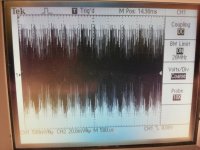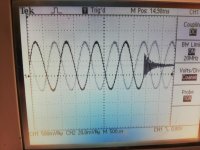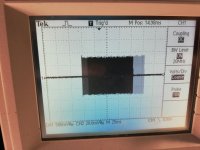in essence, the 'noDAC' is nothing more than a powered isolator. I tried it and concluded that the main sticking point is sample rate. If the DSD rate is 256 or higher then the top-end filters can be less destructive. In the end, the sound was not sufficiently improved for me to put in the work to transition my atypical system. I remain interested in the cause for the sonic differences between PCM and DSD, and my working hypothesis is that some artifact of PCM is actually manifest at the level of driver cones. ...which is consistent with the range of reactions to the 'noDAC' method, as the properties of our speakers undoubtedly vary tremendously.
Yeah in some systems DSD128 was the big improvement with some not noticing any big change between that and DSD256. Other systems swear by the improvements gained by shifting the noise into the higher spectrum. I'm sure some systems prefer PCM over a noDac. I think it depends on the implementation of the noDac or the DAC. I plan on copying hazard's latest noDac efforts. As far as isolation, I will be using twisted pear teleporters, which should handle that.
I plan on copying hazard's latest noDac efforts. As far as isolation, I will be using twisted pear teleporters, which should handle that.
i am very interested in your idea, please post some photos if you will
Hey there Presley,
I'm getting closer to working on audio projects again, hope to have some photos for ya soon, next month or so maybe.
GREAT NEWS! if you are successful I would love to buy a noDAC from you. or maybe you can post a step by step tutorial so i can do it myself? maybe you can make a new thread and the first page of it should be like a work in progress tutorial thats being updated
that clearly demonstrates the multi Mhz spikes you feed straight into your amps...
Wondering if high quality, naked foil resistors, or exotic caps would make a difference in this noDac circuit? I mean we normally take great care with anything in the audio path. But is it necessary here? This is sort of a hybrid ana/digi, right?
I don't know what the latest circuit looks like, but assuming you are referring to a reconstruction filter: the reconstruction filter is completely analogue and handles the desired signal as well as a lot of high-frequency quantization noise. Having components with reasonable high-frequency performance (which implies reasonably small size and short or no leads) will be more important than in a "normal" audio circuit, everything else is just as critical or as uncritical as in a circuit that only handles the audio signal itself.
Last edited:
whats your opinion about FiiO E10K USB DAC and Headphone Amplifier it has an excellent quality of sound, Lightweight design to fit in your palm with the affordable price also there are some list also available here The Best DAC of 2018
A nice thing about a passive RC filter or RLC filter, as compared to active filters, is that they have no problems with the sharp edges, that is, no slewing or sub-slewing TIM. Active filters may or may not have problems with the sharp edges, depending on how they are designed.
I just bumped into this thread while on vacation on Bali ;-)
Very interesting!
Puzzles me it has become quite quiet lately..
Anyways, I wanted to try it so I got an Amanero combo384 and made a L-C-L-C lowpasfilter for the DSD stream.
I use Jriver as sound software and I downloaded some test files from here:
FREE samples DSF audio files
I tried the 1Khz -11dB file, but only got noise out. See pic 1.
Lriver sees it as a 382,5Khz 64 bit and amanero dosent recognize it as DSD either.
So I let Jriver convert all incoming formats to DSDx4 and now amanero puts up the DSD flag and out of the lowpasfilter comes a 1khz sinus Pic. 2.BUT
Something is wrong. You can clearly see the trigger is being f''''' up by this .
If I adjust the time base on the scope, I could see that the sinus is interrupted by silence half of the time.
What is going on here?
Can anybody help me?
Very interesting!
Puzzles me it has become quite quiet lately..
Anyways, I wanted to try it so I got an Amanero combo384 and made a L-C-L-C lowpasfilter for the DSD stream.
I use Jriver as sound software and I downloaded some test files from here:
FREE samples DSF audio files
I tried the 1Khz -11dB file, but only got noise out. See pic 1.
Lriver sees it as a 382,5Khz 64 bit and amanero dosent recognize it as DSD either.
So I let Jriver convert all incoming formats to DSDx4 and now amanero puts up the DSD flag and out of the lowpasfilter comes a 1khz sinus Pic. 2.BUT
Something is wrong. You can clearly see the trigger is being f''''' up by this .
If I adjust the time base on the scope, I could see that the sinus is interrupted by silence half of the time.
What is going on here?
Can anybody help me?
Attachments
Noone can help?
When I tried it there were no issues other than ‘what is the best filter?’ I would investigate your Amanero drivers - not all are equal - but I don’t use one and can’t advise.
When I tried it there were no issues other than ‘what is the best filter?’ I would investigate your Amanero drivers - not all are equal - but I don’t use one and can’t advise.
Thanks, I will
I think a lot of people, including me, have moved onto this approach to DSD playback;
Signalyst DSC1
If you check out the last few pages of the signalyst thread you should find some info on the best Amanero firmware for DSD.
Signalyst DSC1
If you check out the last few pages of the signalyst thread you should find some info on the best Amanero firmware for DSD.
Thanks, I have now actually read that thread too now and I noticed the mention of the software update. I also noticed it at this page:I think a lot of people, including me, have moved onto this approach to DSD playback;
Signalyst DSC1
If you check out the last few pages of the signalyst thread you should find some info on the best Amanero firmware for DSD.
PureDSD
Aparently this is a must for the amanero USB board?
- Home
- Source & Line
- Digital Line Level
- The Best DAC is no DAC


